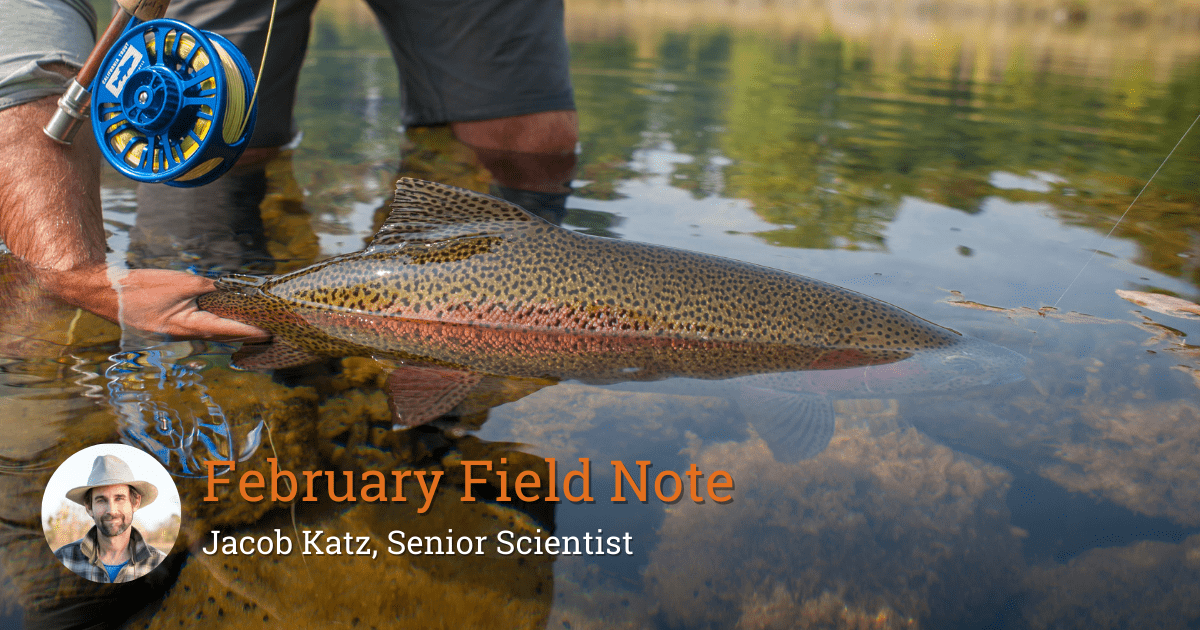Field Note: If You Look Deep Into the Eyes of a Fish, It Will Tell You Its Life Story

By Jacob Katz, Ph.D.
CalTrout Central Valley Regional Director
If You Look Deep Into the Eyes of a Fish, It Will Tell You Its Life Story
At least, that’s what CalTrout’s most recently published research, led by our partners at UC Davis, suggests. The study, just published in the journal Methods in Ecology and Evolution, demonstrated that stable isotopic analysis of salmon eye lenses can reveal a fish’s life history: where it swam and what it ate along the way. The work has major implications for tracking how salmon use floodplain habitat and for understanding how the Central Valley’s altered landscape is impacting fish populations.
The study’s lead author, Miranda Bell Tilcock, was CalTrout’s very first field biologist on the Nigiri Project and is now working on her PhD at UCD Center for Watershed Sciences. Way to go Mir!
“Even the nerdiest fish biologists say, ‘You can do what with fish eyes?’” remarked co-author Rachel Johnson, a research fisheries biologist with NOAA Fisheries’ Southwest Fisheries Science Center and an associate with the UC Davis Center for Watershed Sciences.
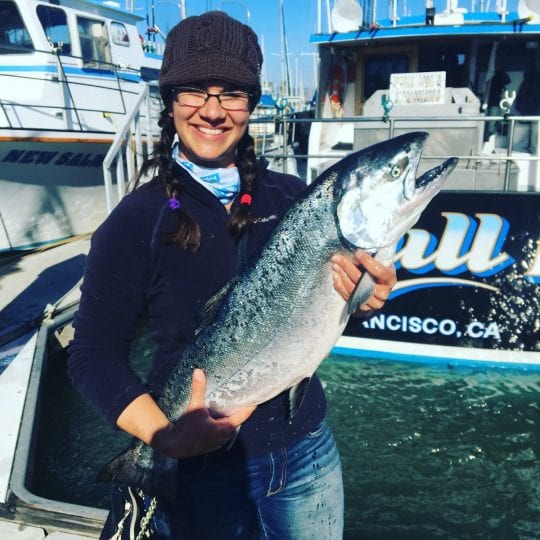
Photo: Study lead author Miranda Tilcock pioneered a technique for freshwater fish that involves peeling its eye lenses to reveal its dietary and habitat history. Here, she holds a salmon. Credit: Courtesy Miranda Tilcock/UC Davis
The Eyes Have It
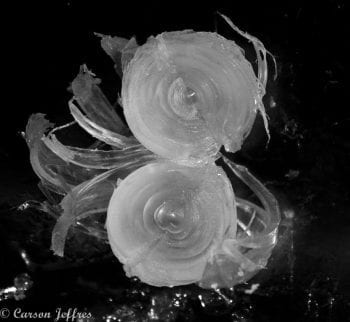
Photo: Dissection of a tuna eye by Carson Jeffres
Much like tree rings, fish eyeballs grow in layers. As new layers form throughout a fish’s life, the layers incorporate the atoms and chemicals from the water in which the fish is swimming and the prey that the fish is consuming at the time.
Relative to other archival tissue, fish eyeballs are especially rich in protein that is particularly good at holding onto stable isotopes. The isotopic values in the food webs bind to protein in the eye, leaving tell-tale geochemical fingerprints that isotopic analysis can decode.
Stable isotopes are forms of atoms that don’t decay into other elements and are incorporated into fish tissue through the fish’s diet. Each eye lens layer records the chemical atomic signatures of the food found in the habitat where the fish is at the time the layer forms. This turns the eye into an archival history of what the fish ate in each habitat.
Tilcock quips, “It’s like a little diet journal the fish keeps for us, which is really nice.”
To read this isotopic history, Tilcock uses fine-tipped forceps to remove layer after layer, revealing a veritable Russian Nesting Doll of eye lens layers. In the center is a tiny ball, something like what you’d find in a silica packet, which can shatter like glass. This is the core, where the fish’s eyes first began to develop.
Habitat is in the Eyes of the Beholder
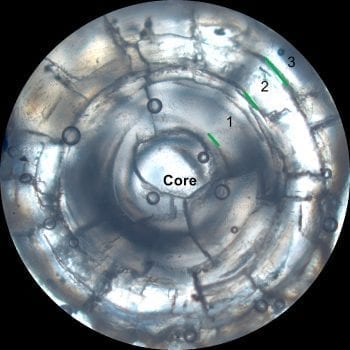
Photo: The eye lens of a hatchery fish under a microscope by UC Davis
Taking the premise of “You Are What You Eat,” we looked at the atomic crumbs – the isotopic values of carbon, nitrogen and sulfur – found in each eye lenses layer to determine which habitat, hatchery, floodplain or river, a fish was eating in at the time of the lense formed.
Because certain stable isotopes are more or less frequent in specific types of habitat, the isotopic “fingerprint” found in each eye lens layer can be used to reconstruct which types of habitat the fish used throughout its life. Knowing habitat use is critically important to salmon conservation because more than 95% of Central Valley floodplains, the very habitats where abundant fish food resources are created, have been drained or are otherwise unavailable to juvenile salmon.
Over the past decade our research has shown that fish reared in the floodplain grow more quickly and pack on much more healthy fat than fish reared in the river or hatchery. CalTrout, has been a vocal advocate for restoring the connection between river channels, now mostly leveed, and the rivers fish food pantry on the floodplain.
This study documented that floodplain-reared fish also appear to grow additional laminae, or layers of eye lenses compared to fish reared in hatcheries or the river. The floodplain habitats, so rich in fish food, also appear to be rich in unique sulfur and carbon values — allowing us to determine if an individual fish has or has not used floodplain habitats. Now, with these isotopic tools, we should be able to definitively test our foundational hypothesis, that fish that can get onto floodplain habitats and fatten up on abundant floodplain food webs, return from the ocean to spawn at much higher rates than fish stuck in the “food desert” of the leveed river channels.
Eyes and Ears
But eyes aren’t the only fish tissue that accumulates distinctive isotopic signatures. Otoliths — bones found within a fish’s ears — incorporate several kinds of strontium isotope whose ratios are distinctive of specific watersheds.
“You use the otolith to trace the river or hatchery where a fish was born, based on the unique geology and water chemistry of the tributaries in the San Francisco Bay watershed,” Johnson explained. Now, we can also use the eye lens — which tells you where the fish is eating — to help identify if a returning adult salmon used floodplain habitats when it was young.
“Anaylsis of both the eyes and ears really work together to present a fuller picture of how salmon move and what they eat as they use different mosaics of habitats across the landscape over their lifetime” commented Carson Jeffres, co-author and field and lab director at UC Davis’ Center for Watershed Science. “Now we have the tool we have been looking for to link juvenile floodplain benefits across the salmon life cycle to adulthood. It’s the holy grail of measuring restoration success.”
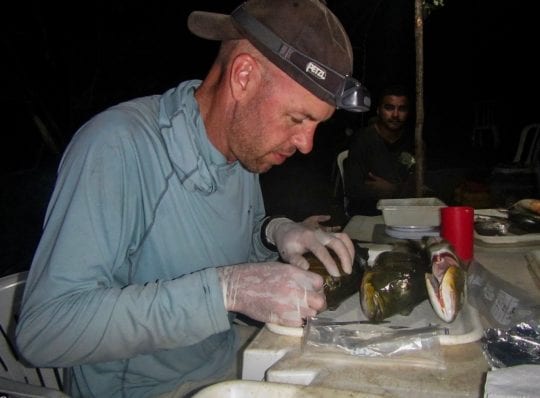
Photo: Carson Jeffres peels the eye lenses of a fish in Brazil to learn about its life history by Carson Jeffres/UC Davis
To learn more, listen to Miranda on NPR’s Science Friday as she tells host Ira Flatow how de-laminating fish eyeballs with tiny tweezers “is just like peeling the world’s tiniest onion.”
This article was adapted from a UC Davis press release.
The study was funded by the California Department of Water Resources.
Additional study co-authors include George Whitman and Andrew Rypel, holder of the Peter B. Moyle and California Trout Endowed Chair in Cold Water Fishes at UCD, and Ted Sommer, lead scientist at the California Department of Water Resources.
Journal Reference:
- Miranda Bell‐Tilcock, Carson A. Jeffres, Andrew L. Rypel, Ted R. Sommer, Jacob V. E. Katz, George Whitman, Rachel C. Johnson. Advancing diet reconstruction in fish eye lenses. Methods in Ecology and Evolution, 2021; DOI: 10.1111/2041-210X.13543


